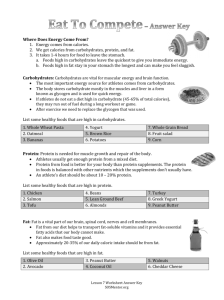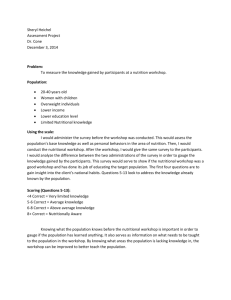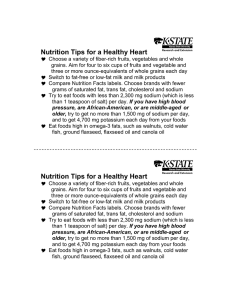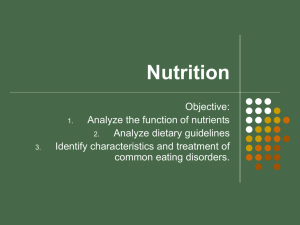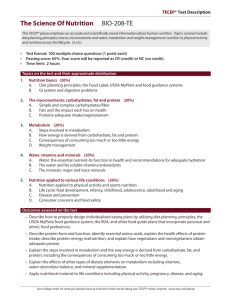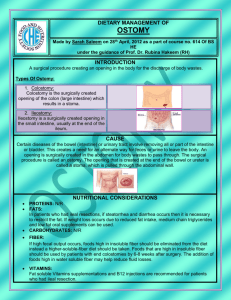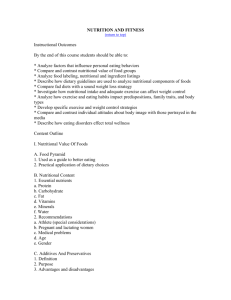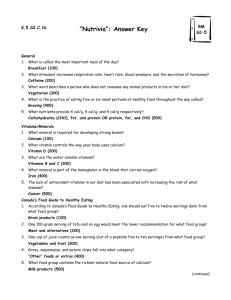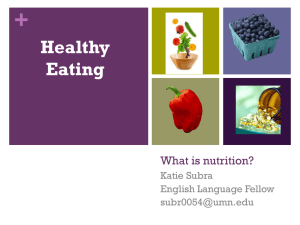Biology 155, Nutrition
advertisement
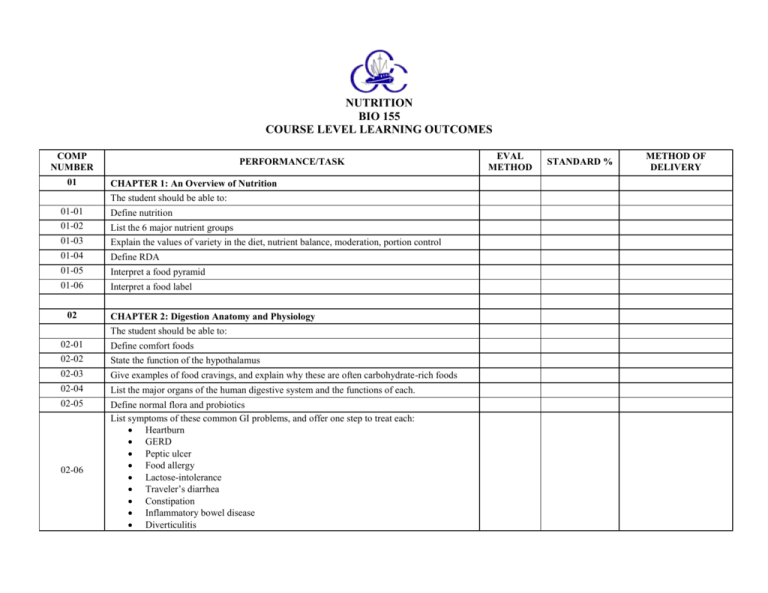
NUTRITION BIO 155 COURSE LEVEL LEARNING OUTCOMES COMP NUMBER 01 PERFORMANCE/TASK CHAPTER 1: An Overview of Nutrition The student should be able to: 01-01 Define nutrition 01-02 List the 6 major nutrient groups 01-03 Explain the values of variety in the diet, nutrient balance, moderation, portion control 01-04 Define RDA 01-05 Interpret a food pyramid 01-06 Interpret a food label 02 CHAPTER 2: Digestion Anatomy and Physiology The student should be able to: 02-01 Define comfort foods 02-02 State the function of the hypothalamus 02-03 Give examples of food cravings, and explain why these are often carbohydrate-rich foods 02-04 List the major organs of the human digestive system and the functions of each. 02-05 Define normal flora and probiotics List symptoms of these common GI problems, and offer one step to treat each: Heartburn GERD Peptic ulcer Food allergy Lactose-intolerance Traveler’s diarrhea Constipation Inflammatory bowel disease Diverticulitis 02-06 EVAL METHOD STANDARD % METHOD OF DELIVERY COMP NUMBER 03 PERFORMANCE/TASK CHAPTER 3: Carbohydrates The student should be able to: 03-01 Define and give examples of each of these: monosaccharides, disaccharides, polysaccharides 03-02 State at least three reasons for the importance of fiber in the diet 03-03 Define whole grain, “enriched” and “refined” wheat flour Explain what is meant by the glycemic index of a food. What is this not the same as its carb content? State at least three reasons to avoid regular consumption of soft drinks 03-04 03-05 03-06 03-07 04 Compare and contrast sugar and artificial sweeteners. Distinguish among Diabetes Type I, Insulin-resistance, diabetes Type II and gestational diabetes regarding cause, symptoms, prevention and treatment options. CHAPTER 4: The Lipids: Triglycerides, Phospholipids, and Sterols The student should be able to: 04-01 Define saturated fat, monounsaturated fat, polyunsaturated fat, and trans fat. 04-02 List 3 health requirements for fat 04-03 List 3 health consequences of too much or the wrong kinds of dietary fat 04-04 Explain the caloric differences between 1 g. of carbohydrate or protein and 1 g. of fat 04-05 Name several foods high in trans fats. 04-06 Name several foods that are sources of good dietary fats. 04-07 Explain the relationship among fat, cholesterol, HDL, LDL, glucose and atherosclerosis. 05 CHAPTER 5: protein: Amino Acids The student should be able to: 05-01 Define protein in terms of structure 05-02 List examples of protein-rich foods 05-03 State whether average Americans meet the RDA EVAL METHOD STANDARD % METHOD OF DELIVERY COMP NUMBER PERFORMANCE/TASK 05-04 Name the group of humans most vulnerable to protein malnutrition 05-05 Explain how the Atkins diet works, and state a caution concerning this diet 05-06 Explain how vegetarians can meet their dietary needs for essential and non-essential amino acids 06 CHAPTER 6: Vitamins The student should be able to: 06-01 Define vitamin 06-02 List the major recognized vitamins and tell whether each is water-or fat-soluble 06-03 Name at least two food sources for each of the vitamins 06-04 Compare whole-foods with vitamin tablets, regarding nutritional value 06-05 Define antioxidant and give several food examples 06-06 Define phytochemicals and list purported health benefits 06-07 State at least two diseases caused by vitamin insufficiency 07 CHAPTER 7: Minerals The student should be able to; 07-01 Define electrolytes 07-02 List ten required minerals and a rich food source for each 07-03 State at least two diseases caused by mineral insufficiency 07-04 Define osteoporosis, give the risk factors, and state ways to possibly prevent and treat this condition EVAL METHOD STANDARD % METHOD OF DELIVERY COMP NUMBER 08 PERFORMANCE/TASK CHAPTER 8: Fluid Balance, Water and Alcohol The student should be able to: 08-01 Write a short essay explaining the necessity of water in cells 08-02 Explain the symptoms and treatment for dehydration, heat exhaustion and heat stroke 08-03 State why alcohol consumption can lead to dehydration, to cirrhosis and to fetal alcohol syndrome, and possibly also to Alzheimer’s disease and cancers. 09 CHAPTER 9: Weight Management The student should be able to: 09-01 Write a short essay explaining the factors underlying the fact that Americans tend to be obsess 09-02 Define BMI 09-03 Define BMR 09-04 List ten things that someone should do if he or she desires to lose a large amount of weight 09-05 List the symptoms of at least two eating disorders 10 CHAPTER 10: Physical Activity The student should be able to: 10-01 State the major health benefits of regular, moderate exercise for the average person 10-02 Explain how exercise boosts metabolism 10-03 Delineate the special nutritional needs of an athlete EVAL METHOD STANDARD % METHOD OF DELIVERY COMP NUMBER 11 PERFORMANCE/TASK CHAPTER 11: Nutrition throughout the Life Cycle The student should be able to: 11-01 12 State the major nutritional requirements of a newborn, a teen, an adult, a pregnant woman, and an older adult CHAPTER 12: Nutrition Issues The student should be able to: 12-01 Discuss several ways to prevent food-borne illensses 12-02 Define food security, GMOs, food additives, organic foods and malnutrition 12-03 List the three types of malnutrition and several factors that contribute to each 12-04 Name two diseases that result from specifically from malnutrition EVAL METHOD STANDARD % METHOD OF DELIVERY
